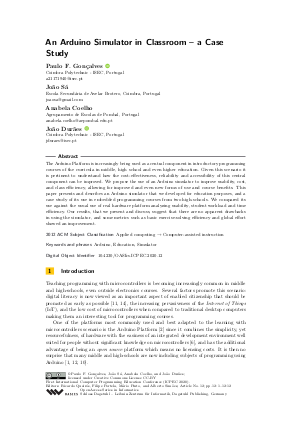An Arduino Simulator in Classroom - a Case Study
Authors
Paulo F. Gonçalves  ,
João Sá,
Anabela Coelho,
João Durães
,
João Sá,
Anabela Coelho,
João Durães 
-
Part of:
Volume:
First International Computer Programming Education Conference (ICPEC 2020)
Part of: Series: Open Access Series in Informatics (OASIcs)
Part of: Conference: International Computer Programming Education Conference (ICPEC) - License:
 Creative Commons Attribution 3.0 Unported license
Creative Commons Attribution 3.0 Unported license
- Publication Date: 2020-06-15
File

PDF
OASIcs.ICPEC.2020.12.pdf
- Filesize: 0.61 MB
- 12 pages
Document Identifiers
Subject Classification
ACM Subject Classification
- Applied computing → Computer-assisted instruction
Keywords
- Arduino
- Education
- Simulator
Metrics
- Access Statistics
-
Total Accesses (updated on a weekly basis)
0Document
0Metadata
Abstract
The Arduino Platform is increasingly being used as a central component in introductory programming courses of the curricula in middle, high school and even higher education. Given this scenario it is pertinent to understand how the cost-effectiveness, reliability and accessibility of this central component can be improved. We propose the use of an Arduino simulator to improve usability, cost, and class efficiency, allowing for improved and even new forms of use and course benefits. This paper presents and describes an Arduino simulator that we developed for education purposes, and a case study of its use in embedded programming courses from two high-schools. We compared its use against the usual use of real hardware platform analyzing usability, student workload and time efficiency. Our results, that we present and discuss, suggest that there are no apparent drawbacks in using the simulator, and some metrics such as basic exercise-solving efficiency and global effort showed an improvement.
Cite As Get BibTex
Paulo F. Gonçalves, João Sá, Anabela Coelho, and João Durães. An Arduino Simulator in Classroom - a Case Study. In First International Computer Programming Education Conference (ICPEC 2020). Open Access Series in Informatics (OASIcs), Volume 81, pp. 12:1-12:12, Schloss Dagstuhl – Leibniz-Zentrum für Informatik (2020)
https://doi.org/10.4230/OASIcs.ICPEC.2020.12
BibTex
@InProceedings{goncalves_et_al:OASIcs.ICPEC.2020.12,
author = {Gon\c{c}alves, Paulo F. and S\'{a}, Jo\~{a}o and Coelho, Anabela and Dur\~{a}es, Jo\~{a}o},
title = {{An Arduino Simulator in Classroom - a Case Study}},
booktitle = {First International Computer Programming Education Conference (ICPEC 2020)},
pages = {12:1--12:12},
series = {Open Access Series in Informatics (OASIcs)},
ISBN = {978-3-95977-153-5},
ISSN = {2190-6807},
year = {2020},
volume = {81},
editor = {Queir\'{o}s, Ricardo and Portela, Filipe and Pinto, M\'{a}rio and Sim\~{o}es, Alberto},
publisher = {Schloss Dagstuhl -- Leibniz-Zentrum f{\"u}r Informatik},
address = {Dagstuhl, Germany},
URL = {https://drops.dagstuhl.de/entities/document/10.4230/OASIcs.ICPEC.2020.12},
URN = {urn:nbn:de:0030-drops-122996},
doi = {10.4230/OASIcs.ICPEC.2020.12},
annote = {Keywords: Arduino, Education, Simulator}
}
Author Details
References
-
Francesca Agatolio and Michele Moro. A workshop to promote arduino-based robots as wide spectrum learning support tools. In Robotics in Education, pages 113-125. Springer, 2017.

- Arduino.cc. Arduino - home, 2018. URL: https://www.arduino.cc/.
-
Atmel. AVR Instruction Set Manual, 2016.

-
Atmel. ATmega328/P Datasheet, 2018.

- Avrdude. Avr downloader/uploader, 2019. URL: https://www.nongnu.org/avrdude/.
-
Hernando Barragán. Wiring: Prototyping physical interaction design. Interaction Design Institute, Ivrea, Italy, 2004.

-
Edward Currie and Carl James-Reynolds. The use of physical artefacts in undergraduate computer science teaching. In E-Learning, E-Education, and Online Training, pages 119-124. Springer, 2017.

- Paulo F. Gonçalves, Jorge Bernardino, and João Durães. Virtualization technologies for arduino simulation. In 2019 14th Iberian Conference on Information Systems and Technologies (CISTI). IEEE, June 2019. URL: https://doi.org/10.23919/cisti.2019.8760727.
-
Sandra G Hart and Lowell E Staveland. Development of nasa-tlx (task load index): Results of empirical and theoretical research. In Advances in psychology, volume 52, pages 139-183. Elsevier, 1988.

-
Peter Jamieson. Arduino for teaching embedded systems. are computer scientists and engineering educators missing the boat? In Proceedings of the International Conference on Frontiers in Education: Computer Science and Computer Engineering (FECS), page 1. The Steering Committee of The World Congress in Computer Science, Computer Engineering and Applied Computing (WorldComp), 2011.

-
Marc Prensky. Programming is the new literacy. Edutopia magazine, 2008.

-
John Sarik and Ioannis Kymissis. Lab kits using the arduino prototyping platform. In 2010 IEEE Frontiers in Education Conference (FIE), pages T3C-1. IEEE, 2010.

-
Robert F Tate. Correlation between a discrete and a continuous variable. point-biserial correlation. The Annals of mathematical statistics, 25(3):603-607, 1954.

- Annette Vee. Understanding computer programming as a literacy. Literacy in Composition Studies, 1(2):42-64, 2013. URL: https://doi.org/10.21623/1.1.2.4.
